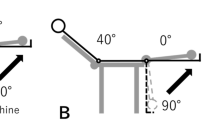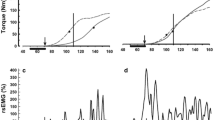Abstract
Sudden loading of the spine is not only considered a risk factor for the development of low-back pain but also enables an evaluation of the stability of the spine when conducted under laboratory conditions. In the present study the upper spine was pulled in the anterior direction and the stiffness as well as activity in the erector spinae muscle was measured with different pre-tension in the erector spinae. The results showed that increased activity in the erector spinae prior to loading led to increased stiffness (stiffness coefficients from 297 Nm rad−1 to 438 Nm rad−1) and a decrease in the extra neural signal input to the muscles to maintain the stability. It is therefore clear that increased tension in the erector spinae muscle will create a larger stability of the spine to anterior perturbations. However, contracting the muscles around the spine increases the load on the spinal structures. In 34% of the experiments a silent period in the electromyographic signal was present after loading in the period when the torso was moving in the anterior direction. This phenomenon is discussed.




Similar content being viewed by others
References
Aoki H, Tsukahara R, Yabe K (1989) Effects of pre-motion electromyographic silent period on dynamic force exertion during a rapid ballistic movement in man. Eur J Physiol Occup Physiol 58:426–432
Armitage P, Berry G (1994) Statistical methods in medical research, 3rd edn. Blackwell, London
Asmussen E, Bonde-Petersen F (1974) Storage of elastic energy in man. Acta Physiol Scand 91:385–392
Bernard B (1997) Musculoskeletal disorders and workplace factors: a critical review of epidemiologic evidence for work-related musculoskeletal disorders of the neck, upper extremity, and low back, 2nd edn. Department of Health and Human Services, NIOSH, Cincinnati
Bull Andersen T, Schibye B, Skotte J (2001) Sudden movements of the spinal column during health-care work. Int J Ind Ergon 28:47–53
Cavagna G (1977) Storage and utilization of elastic energy in skeletal muscle. Exerc Sport Sci Rev 5:89–129
Cholewicki J, McGill S (1996) Mechanical stability of the in-vivo lumbar spine: implications for injury and chronic low back pain. Clin Biomech 11:1–15
Cholewicki J, Juluru K, Radebold A, Panjabi M, McGill S (1999) Lumbar spine stability can be augmented with an abdominal belt and/or increased intra-abdominal pressure. Eur Spine J 8:388–395
Cholewicki J, Simons A, Radebold A (2000) Effects of external trunk loads on lumbar spine stability. J Biomech 33:1377–1385
Dolan P, Adams M (1993) The relationship between EMG activity and extensor moment generation in the erector spinae muscles during bending and lifting activities. J Biomech 26:513–522
Dyhre-Poulsen P, Laursen A (1984) Programmed electromyographic activity and negative incremental muscle stiffness in monkeys jumping downward. J Physiol (Lond) 350:121–136
Dyhre-Poulsen P, Simonsen E Voigt M (1991) Dynamic control of muscle stiffness and H reflex modulation during hopping and jumping in man. J Physiol (Lond) 437:287–304
Fenn W (1924) The relation between the work performed and the energy liberated in muscular contraction. J Physiol (Lond) 58:373–395
Granata K Marras W (2000) Cost-benefit of muscle contraction in protecting against spinal instability. Spine 25:1398–1404
Grob D, Dvorak J (1991) Temporary segmental fixation of the cervical spine. Europeean Spine Society, Rome
Hodges P, Bui B (1996) A comparison of computer-based methods for the determination of onset of muscle contraction using surface electromyography. Electroencephalogr Clin Neurophysiol 101:511–519
Laursen A, Dyhre-Poulsen P, Djorup A, Jahnsen H (1978) Programmed pattern of muscular activity in monkeys landing from a leap. Acta Physiol Scand 102:492–494
Lavender S, Mirka G, Schoenmarklin R, Sommerich C, Sudhakar L, Marras W (1989) The effects of preview and task symmetry on trunk muscle response to sudden loading. Hum Factors 31:101–115
Manning D, Mitchell R, Blanchfield L (1984) Body movements and events contributing to accidental and nonaccidental back injuries. Spine 9:734–739
Mannion A, Adams M, Dolan P (2000) Sudden and unexpected loading generates high forces in the lumbar spine. Spine 25:842–852
Morgan D (1977) Separation of active and passive components of short-range stiffness of muscle. Am J Physiol 232:45–49
Panjabi M (1992a) The stabilizing system of the spine. Part I. Function, dysfunction, adaptation, and enhancement. J Spinal Disord 5:383–389
Panjabi M (1992b) The stabilizing system of the spine. Part II. Neutral zone and instability hypothesis. J Spinal Disord 5:390–397
Press W, Teukolsky S, Vetterling W, Flannery B (1992) Numerical recipes in Fortran, the art of scientific computing, 2nd edn. Cambridge University Press, Cambridge
Stokes I, Gardner-Morse M, Henry S, Badger G (2000) Decrease in trunk muscular response to pertubation with preactivation of lumbar spinal musculature. Spine 25:1957–1964
Tanii K (1996) Comparative study of the premovement muscle silent period and the premovement cortical potential in different modes of voluntary contraction. Electromyogr Clin Neurophysiol 36:99–105
Thomas J, Lavender S, Corcos D, Andersson G (1998) Trunk kinematics and trunk muscle activity during a rapidly applied load. J Electromyogr Kinesiol 8:215–225
Wierzbicka M, Wolf W, Staude G, Konstanzer A, Dengler R (1993) Inhibition of EMG activity in isometrically loaded agonist muscle preceding a rapid contraction. Electromyogr Clin Neurophysiol 33:271–278
Wilder D, Aleksiev A, Magnusson M, Pope M, Spratt K, Goel V (1996) Muscular response to sudden load. A tool to evaluate fatigue and rehabilitation. Spine 21:2628–2639
Winter D (1990) Biomechanics and motor control of human movement, 2nd edn. Wiley, New York
Yabe K (1976) Premotion silent period in rapid voluntary movement. J Appli Physiol 41:470–473
Young H, Freedman R (1996) University Physics, 9th edn. Addison-Wesley, Reading, Mass.
Author information
Authors and Affiliations
Corresponding author
Rights and permissions
About this article
Cite this article
Bull Andersen, T., Essendrop, M. & Schibye, B. Movement of the upper body and muscle activity patterns following a rapidly applied load: the influence of pre-load alterations. Eur J Appl Physiol 91, 488–492 (2004). https://doi.org/10.1007/s00421-004-1040-6
Accepted:
Published:
Issue Date:
DOI: https://doi.org/10.1007/s00421-004-1040-6




